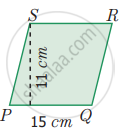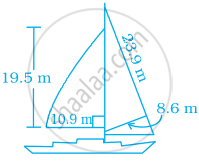Advertisements
Advertisements
Question
The area of a rhombus is 100 sq.cm and length of one of its diagonals is 8 cm. Find the length of the other diagonal
Solution
Given the length of one diagonal d1 = 8 cm
Area of the rhombus = 100 sq.cm
`1/2` (d1 × d2) = 100
`1/2 xx 8 xx "d"_2` = 100
8 × d2 = 100 × 2
d2 = `(100 xx 2)/8`
= 25 cm
Length of the other diagonal d2 = 25 cm
APPEARS IN
RELATED QUESTIONS
If length of a diagonal of a rhombus is 30 cm and its area is 240 sq cm, find its perimeter.
A thin metal iron-sheet is rhombus in shape, with each side 10 m. If one of its diagonals is 16 m, find the cost of painting both sides at the rate of ₹ 6 per m2. Also, find the distance between the opposite sides of this rhombus.
The area of a rhombus is equal to the area of a triangle. If the base ∆ is 24 cm, its corresponding altitude is 16 cm and one of the diagonals of the rhombus is 19.2 cm. Find its other diagonal.
Find the area of rhombus PQRS shown in the following figure.
Find the missing value.
| Diagonal (d1) | Diagonal (d2) | Area |
| 12 mm | 180 sq.mm |
The area of the rhombus is 128 sq.cm and the length of one diagonal is 32 cm. The length of the other diagonal is
The figure ABCD is a quadrilateral in which AB = CD and BC = AD. Its area is ______.

If the diagonals of a rhombus get doubled, then the area of the rhombus becomes ______ its original area.
The area of a rectangular field is 48 m2 and one of its sides is 6 m. How long will a lady take to cross the field diagonally at the rate of 20 m/minute?
Most of the sailboats have two sails, the jib and the mainsail. Assume that the sails are triangles. Find the total area sail of the sailboats to the nearest tenth.

